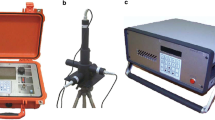Abstract
In a general treatment of the theory of induction logging, an exact integral representation has been obtained for the mutual impedance between a vertical dipole transmitter and a coaxial dipole receiver in a three layered earth. Based on this representation, a computer model has been devised using the traditional Slingram system of induction logging and the comparatively new Turam system, ignoring borehole effects. The model results indicate that due to its much larger response, the Turam system is in general preferable to the Slingram in mineral and groundwater investigations where formation conductivity much less than 1 S/m is generally encountered. However, if the surrounding media are conductive (more than 0.1 S/m), the Turam system suffers from large amplitude attenuation and phase rotation of the primary field caused by the conductive surrounding, and is less useful than the Slingram system which does not so suffer, unless the target bed is shallow. Because it is a more complex function of system parameters than the corresponding Slingram log, a Turam log can be conveniently interpreted only by the modern inverse method using a fast algorithm for the forward solution and a high speed digital computer.
Similar content being viewed by others
References
Chang, S. K. andAnderson, B. (1984),Simulation of Induction Logging by the Finite Element Method. Geophysics49, 1943–1958.
Doll, H. G. (1949),Introduction to Induction Logging and Application to Logging of Wells drilled with oil base mud. J. Pet. Tech.1, 148–162.
Fuller, J. A. andWait, J. R. (1973),Mutual Electromagnetic coupling of Coaxial Loop in a Borehole. Radio Science8, 453–457.
Keller, G. V. andFrischknecht, F. C. (1966),Electrical Methods in Geophysical Prospecting. Pergamon 517 p.
Locke, S. (1969),The Wedge Problem for Induction Sondes. Schlumberger Res. Report No. 21-51-19, Schlumberger-Doll Research, Ridgefield, Connecticut.
Moran, J. H. andKunz, K. S. (1962),Basic Theory of Induction Logging and Application to Study of two-coil sondes. Geophysics27, 829–858.
Poddar, M. (1983),A Rectangular Loop Source of Current on Multilayered Earth. Geophysics48, 107–109.
Wait, J. R. (1951),The Magnetic Dipole over the Horizontally Stratified Earth. Can. J. Phys.20, 577–592.
Wharton, R. P. (1975)A Difference Potential Method for Induction sondes. IEEE Trans. on Geosci. Electr. GE 13, 87–92.
Author information
Authors and Affiliations
Rights and permissions
About this article
Cite this article
Poddar, M., Caleb Dhanasekaran, P. & Prabhakar Rao, K. Comparison between moving and stationary transmitter systems in induction logging. PAGEOPH 123, 707–731 (1985). https://doi.org/10.1007/BF00878404
Received:
Revised:
Issue Date:
DOI: https://doi.org/10.1007/BF00878404




